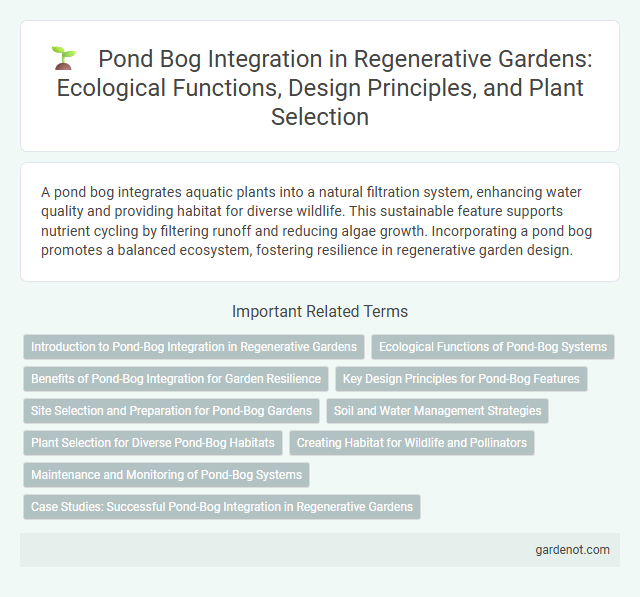A pond bog integrates aquatic plants into a natural filtration system, enhancing water quality and providing habitat for diverse wildlife. This sustainable feature supports nutrient cycling by filtering runoff and reducing algae growth. Incorporating a pond bog promotes a balanced ecosystem, fostering resilience in regenerative garden design.
Introduction to Pond-Bog Integration in Regenerative Gardens
Pond bogs serve as natural filtration systems in regenerative gardens, combining aquatic and terrestrial plants to improve water quality and support biodiversity. These integrated ecosystems promote nutrient cycling by absorbing excess nitrogen and phosphorus, reducing algae growth and enhancing overall pond health. Their design mimics natural wetlands, fostering habitat diversity and resilience within sustainable garden landscapes.
Ecological Functions of Pond-Bog Systems
Pond-bog systems enhance water filtration by naturally trapping sediments and absorbing nutrients, preventing pollution in downstream ecosystems. These habitats provide critical breeding grounds for amphibians and aquatic invertebrates, supporting biodiversity and ecological balance. The dense vegetation in pond-bogs sequesters carbon, contributing to climate regulation and soil stabilization.
Benefits of Pond-Bog Integration for Garden Resilience
Pond-bog integration enhances garden resilience by creating a balanced aquatic ecosystem that supports diverse plant and animal life, improving water purification and nutrient cycling. This natural filtration system reduces reliance on chemical inputs, fostering healthier soil and promoting robust plant growth in adjacent garden beds. The moisture retention and habitat diversity provided by pond-bogs increase drought tolerance and attract beneficial pollinators and predators, strengthening overall ecosystem stability.
Key Design Principles for Pond-Bog Features
Pond-bog features in regenerative gardens utilize a balance of water retention and filtration through carefully selected native plants like sedges and rushes that thrive in saturated soils. Key design principles include creating gradual slopes to support diverse vegetation zones, ensuring proper water circulation to prevent stagnation, and incorporating layers of gravel and organic materials to enhance natural biofiltration. Integrating these elements promotes biodiversity, improves water quality, and establishes a resilient ecosystem that mimics natural marshes.
Site Selection and Preparation for Pond-Bog Gardens
Selecting an appropriate site for a pond bog garden requires assessing soil permeability, sunlight exposure, and proximity to a natural water source to maintain consistent moisture levels. Preparing the area involves excavating a shallow basin, installing an impermeable liner to retain water, and layering with a mix of sand, gravel, and organic matter to support bog plants like pitcher plants and sphagnum moss. Proper site selection and preparation ensure optimal hydrology and nutrient conditions critical for the thriving of specialized wetland vegetation in regenerative garden ecosystems.
Soil and Water Management Strategies
Pond bogs optimize soil and water management by enhancing natural filtration through dense vegetation that stabilizes soil and reduces erosion. Their organic-rich substrate supports microbial activity, improving nutrient cycling and water retention essential for sustaining surrounding ecosystems. These systems also serve as biofilters, capturing sediments and pollutants, thus maintaining water quality in regenerative gardens.
Plant Selection for Diverse Pond-Bog Habitats
Selecting a diverse range of native aquatic and marginal plants enhances the ecological balance within a pond bog by supporting various wildlife species and improving water quality. Incorporating species such as sedges (Carex spp.), rushes (Juncus spp.), and carnivorous plants like pitcher plants (Sarracenia spp.) creates microhabitats that promote nutrient cycling and habitat complexity. Optimal plant selection tailored to local climate and hydrology fosters resilience in regenerative garden ecosystems, ensuring long-term sustainability and biodiversity.
Creating Habitat for Wildlife and Pollinators
Pond bogs provide essential habitats that support diverse wildlife, including amphibians, insects, and birds, by offering shelter and breeding grounds. Native aquatic plants in pond bogs attract pollinators such as bees, butterflies, and dragonflies, enhancing biodiversity and ecosystem resilience. The rich vegetation also helps maintain water quality and stabilize the pond ecosystem, fostering a balanced environment for pollinators and wildlife.
Maintenance and Monitoring of Pond-Bog Systems
Regular maintenance of pond bog systems involves monitoring water quality parameters such as pH, nutrient levels, and dissolved oxygen to ensure a balanced aquatic environment. Periodic removal of sediment and invasive plant species helps maintain optimal filtration and supports native biodiversity. Continuous observation of plant health and water circulation patterns enhances system resilience and promotes effective nutrient cycling.
Case Studies: Successful Pond-Bog Integration in Regenerative Gardens
Case studies showcase successful pond bog integration in regenerative gardens, highlighting increased biodiversity and natural water filtration. In these projects, native aquatic plants like cattails and sedges create self-sustaining ecosystems that reduce nutrient runoff and support amphibian populations. The regenerative approach enhances soil health and water quality while providing habitat connectivity for wildlife.
Pond bog Infographic

 gardenot.com
gardenot.com